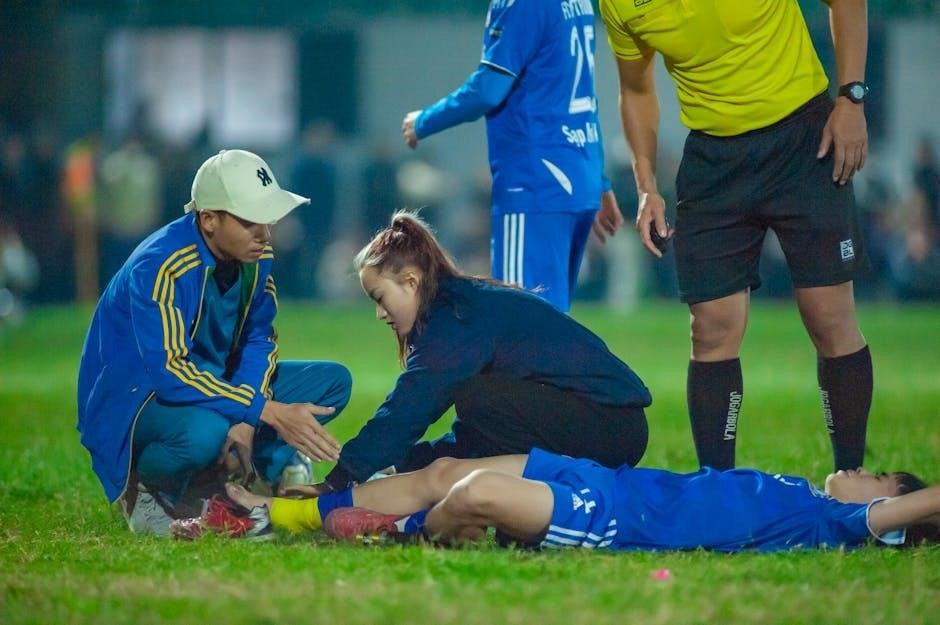greater trochanteric pain syndrome exercises pdf
Greater trochanteric pain syndrome exercises are available online as pdf resources for easy access and reference, providing valuable information and guidance for individuals seeking relief from this condition through exercise and therapy programs.
Definition and Diagnosis
Greater trochanteric pain syndrome is a condition characterized by pain and tenderness in the outer hip area, often diagnosed through a combination of physical examination and medical history. The diagnosis of this condition can be complex, and it is essential to rule out other possible causes of hip pain, such as hip osteoarthritis or stress fractures. A thorough understanding of the definition and diagnosis of greater trochanteric pain syndrome is crucial for developing effective treatment plans, including exercise programs. The internet provides a wealth of information on this topic, including pdf resources that offer guidance on diagnosis, symptoms, and treatment options. These resources can be a valuable tool for healthcare professionals and individuals seeking to understand and manage this condition. By accessing these online resources, individuals can gain a better understanding of the definition and diagnosis of greater trochanteric pain syndrome and explore available treatment options, including exercises and physical therapy programs.

Causes and Risk Factors
Risk factors include repetitive hip movements and poor posture, which can be addressed through targeted exercises and physical therapy, as outlined in various online pdf resources and health articles available today.
Understanding the Role of Hip Osteoarthritis
Hip osteoarthritis plays a significant role in the development of greater trochanteric pain syndrome, as it can cause inflammation and irritation in the affected area, leading to pain and discomfort; According to various online resources, including pdf documents and health articles, hip osteoarthritis can contribute to the onset of greater trochanteric pain syndrome by causing wear and tear on the hip joint, leading to inflammation and irritation of the surrounding tissues. This can be addressed through targeted exercises and physical therapy, as outlined in various online pdf resources and health articles available today. The relationship between hip osteoarthritis and greater trochanteric pain syndrome is complex, and further research is needed to fully understand the underlying mechanisms. However, it is clear that hip osteoarthritis is a significant risk factor for the development of greater trochanteric pain syndrome, and addressing this underlying condition is crucial for effective management and treatment. By understanding the role of hip osteoarthritis, individuals can take steps to prevent and manage greater trochanteric pain syndrome, and improve their overall quality of life.
Symptoms and Clinical Presentation
Symptoms include pain and tenderness, with clinical presentation varying from mild to severe, requiring proper evaluation and diagnosis for effective management and treatment through exercises and therapy.
Differential Diagnosis and Accurate Assessment
Differential diagnosis is crucial in identifying greater trochanteric pain syndrome, as it can be easily confused with other conditions such as hip osteoarthritis or tendinitis. A thorough evaluation, including a physical examination and medical history, is necessary to determine the underlying cause of the pain. The use of imaging tests, such as X-rays or MRI scans, can also help to rule out other conditions and confirm the diagnosis. Accurate assessment is essential to develop an effective treatment plan, which may include exercises and physical therapy to alleviate symptoms and improve mobility. By providing a comprehensive evaluation and diagnosis, healthcare professionals can help individuals with greater trochanteric pain syndrome to manage their condition and improve their quality of life. This information can be found in various online resources, including pdf documents and medical websites, which offer valuable guidance and support for individuals seeking relief from this condition.

Exercises for Greater Trochanteric Pain Syndrome
Exercises are available as pdf downloads, providing stretching and strengthening routines to help alleviate greater trochanteric pain syndrome symptoms and improve mobility naturally through physical therapy programs online.
Importance of Physical Therapy and Rehabilitation
Physical therapy and rehabilitation play a crucial role in the management of greater trochanteric pain syndrome, as they help to improve mobility, reduce pain, and enhance functional ability.
Through a combination of exercises, manual therapy, and education, individuals can learn to manage their symptoms and improve their overall quality of life.
The internet provides a wealth of information on physical therapy and rehabilitation for greater trochanteric pain syndrome, including downloadable pdf resources and online tutorials.
These resources can be a valuable tool for individuals seeking to take an active role in their recovery and management of the condition.
By incorporating physical therapy and rehabilitation into their treatment plan, individuals can reduce their reliance on medication and other interventions, and instead focus on natural and non-invasive methods of managing their symptoms.
This approach can lead to improved outcomes and a better quality of life for individuals with greater trochanteric pain syndrome.

Treatment Options and Management
Treatment involves a range of options, including medication, injections, and alternative therapies, with pdf resources available online to guide management and exercise programs for relief.
Role of Stretching and Strengthening Exercises
Stretching and strengthening exercises play a crucial role in managing greater trochanteric pain syndrome, with pdf resources providing detailed guides on how to perform these exercises correctly.
The exercises help to improve flexibility, reduce pain and inflammation, and strengthen the muscles around the hip joint, leading to improved mobility and function.
A well-structured exercise program can help individuals with greater trochanteric pain syndrome to regain control over their condition and reduce their reliance on medication and other treatments.
By incorporating stretching and strengthening exercises into their daily routine, individuals can improve their overall quality of life and reduce the risk of further complications.
The pdf resources available online provide a valuable tool for individuals to take control of their condition and manage their symptoms effectively, with exercises tailored to meet the specific needs of individuals with greater trochanteric pain syndrome.
These exercises can be modified to suit different fitness levels and abilities, making them accessible to a wide range of individuals.
Overall, stretching and strengthening exercises are a vital component of any treatment plan for greater trochanteric pain syndrome.

PDF Resources for Greater Trochanteric Pain Syndrome Exercises
Online pdf resources provide accessible and informative exercise guides for greater trochanteric pain syndrome management and treatment options readily available for download and reference purposes always.
Access to Reliable and Informative Materials
Having access to reliable and informative materials is crucial for individuals seeking to manage their greater trochanteric pain syndrome through exercise and therapy. The internet provides a vast array of resources, including pdf documents, that offer guidance on exercises and stretches to help alleviate symptoms. These materials can be easily downloaded and accessed at any time, making it convenient for individuals to incorporate them into their daily routine. Many of these resources are created by healthcare professionals and are based on the latest research and findings, ensuring that individuals have access to accurate and up-to-date information. By utilizing these resources, individuals can take an active role in managing their condition and improving their overall quality of life. Online resources also provide a sense of community and support, connecting individuals with others who are going through similar experiences. This can be a valuable source of motivation and encouragement.

